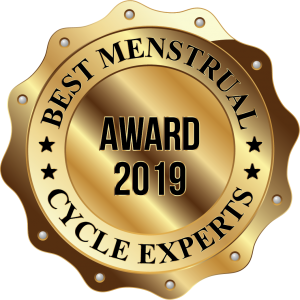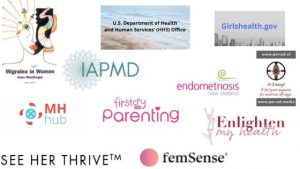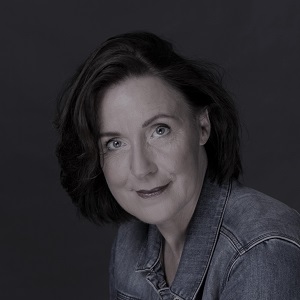

Mind-Blowing Menstrual Cycles Advice You Can’t Miss
The best way to actually learn and be out of pain is to hear from the experts and also put to use what you’ve learned.
For a lot of stories relating to the menstrual cycle, it’s a known fact that most came with much heartbreak and struggle.
That’s why, it is important to understand that your past struggles, failures, highs, and lows to be set free from menstrual pains demands expert’s advice.
And this is exactly what we are going to be talking about in this post as we hear from the best menstrual cycle experts.
Rarely do you hear about this advice from the internet and also find them hitting that tipping point regarding relief advice.
Below are the award-winning menstrual cycles experts advice that you won’t want to miss for anything.
The Menstrual Cycle Phases, Symptoms, Hormones, Calender and Calculator advice from Experts.

We at Period! only have one tip: embrace your menstrual cycle.
Stop feeling embarrassed about possible leakage stains or other visible signs you might be on your period.
Feel proud. Like you would be when you’re pregnant.
Because a regular cycle is a sign of good health. Maybe it’s not your goal right now, but you possibly can get pregnant.
Nothing to feel awkward about, you’re doing mankind a favor.
Yes, the whole process is regulated by hormones.
Hormones are designed to initiate all kinds of bodily changes so it’d be odd if you wouldn’t experience any influence at all.
Of course, there’s a thin line between normal and abnormal. This also has to do with coping.
Menstrual cramp is caused by contractions of the uterus and these contractions are perfectly common.
However, severe cramps can be a sign of a specific health problem, like endometriosis of adenomyosis.
The same goes for slight mood swings: your cycle affects the way you feel. Just before ovulation, your performance in a certain field is better than just before menstruation and vice versa.
There’s nothing wrong by admitting that you’re influenced by your hormones.
Feeling blue for a day or two may be okay, but if you experience depression, irritability, fear, panic attacks, mood swings, anger, trouble sleeping, crying spells, all kinds of physical complaints, and even sometimes suicidal thoughts every cycle, you may have PMS or PMDD.
Sudden changes in your menstrual cycle – like a sudden stop, breakthrough bleeding of heavy blood loss – are also ‘code red’.
Remember: your cycle won’t stay the same your whole menstrual life.
At the beginning and at the end (when you’re in perimenopause), the amount of blood loss and pain can be worse.
No need to panic right away.
However, if you experience discomfort each cycle and if your menstrual problems mean you can’t function in a normal way, it’s definitely a reason to visit your GP.
There’s only one person who can be the judge of what’s a normal cycle. That’s you. Period!
Dutch journalist Paula Kragten is the founding editor of Period! Magazine, an independent online magazine about menstruation in English.

Website: www.period.media & www.period.nl
Instagram: https://www.instagram.com/period.nl
Facebook: https://www.facebook.com/period.nl & https://www.facebook.com/periodmagazine
Twitter: https://twitter.com/PeriodMagazine
Understanding Menstrual Cycles: Award Winners Best Advice

femSense Kinderwunsch is an Ovulation Detection System, so the first tip we would give a young woman about her cycle is that not every woman ovulates on day 14.
The myth that we all ovulate on day 14 is based on a 28 cycle, but as women know, we are not like swiss watches!
We all tick differently and have cycles as individual as we are.
The length of our cycles can even differ from month to month depending on outside influences like sickness or jetlag.
A more realistic date would be that we ovulate 14 days before our period begins.
Knowing exactly when you ovulate makes getting pregnant so much easier and quicker.
For more information on the menstrual cycles visit our blog: https://www.femsense.com/en/blog/what-every-woman-should-know/

Website: https://www.femsense.com/en/
facebook: https://www.facebook.com/hellofemsense/
Instagram: https://www.instagram.com/femsense_/
Twitter: https://twitter.com/hellofemsense
 The Menstrual Health Hub as known is female health, nonprofit and social impact business base in Germany.
The Menstrual Health Hub as known is female health, nonprofit and social impact business base in Germany.
The best tip for a person to know and understand menstrual cycles is to get in touch with their own changes and rhythms.
What does this mean?
Well, first it means understanding what the menstrual cycle is, its distinct phases, the hormones that dance throughout the month and then mapping them onto one’s own life and experiences.
Then, it means being able to understand the whole toolbox of daily fertility awareness method tools.
1.) detailed tracking of symptoms/changes/feelings/diet per day across the cycle, starting with the first day of menstruation as day 1, 2.) taking one’s basal body temperature (BBT) and 3.) checking for changes in cervical mucus across the month.
Having a baseline, taking stock and observing patterns is an evidence-based approach to helping detect irregularities, such an intense and debilitating cramping or pain that requires consistent medical or pharmaceutical attention or cramping at other times in the month, such as around ovulation.
Having a closer relationship with the menstrual cycle is the best entry point to being able to meaningfully understand female reproductive health as a whole across the lifecycle.
Danielle Keiser, CEO and Executive Director of the Menstrual Health Hub (MH Hub) 
Website: https://mhhub.org/
Facebook: https://www.facebook.com/MenstrualHealthHub/
Twitter: https://twitter.com/mhhub_global?lang=en
Instagram: https://www.instagram.com/menstrualhealthhub/
Menstrual Cycle Change
![]() Clare-Louise Knox is a Business Psychologist (MSc), Founder of SEE HER THRIVE and Board Director at the International Association for Premenstrual Disorders (IAPMD).
Clare-Louise Knox is a Business Psychologist (MSc), Founder of SEE HER THRIVE and Board Director at the International Association for Premenstrual Disorders (IAPMD).
Tracking your cycle can provide a huge amount of insight when it comes to your physical and mental health – but tracking is more than just marking in your calendar when your next period is due!
It’s about observing your thoughts, mood, and energy across your cycle, and identifying how these change over time.
It’s about understanding when you’re at your best (for most people it’s when oestrogen is dominant in the first part of their cycle) so you can capitalise on being productive, creative and confident.
About spotting significant changes in your physical and mental health across your cycle (such as cyclical anxiety and depression) which could indicate a condition like Premenstrual Dysphoric Disorder (PMDD).
It’s about learning what is normal – both for you personally and in relation to other women – and not accepting symptoms that severely impact your everyday life.
Because that’s not “normal” or something you should have to live with every month.
If you are struggling as a result of your menstrual cycle, educate yourself (check out evidence-based providers such as IAPMD and Endometriosis UK) speak to a trusted friend or colleague and find a great GP who will give you the treatment and care you deserve.
Clare-Louise Knox is an expert in female reproductive health and the impact it has on women in the workplace, having completed award-nominated academic research in this area and through her own experience of Premenstrual Dysphoric Disorder (PMDD).
Clare-Louise leads weekly seminars on Women’s Mental Health at King’s College London and is part of a government taskforce addressing menstrual stigma and education in the UK.
Website: www.seeherthrive.com
Twitter: @seeherthrive
Insta: @see_her_thrive
Menstrual Cycle Headache
 Professor Anne MacGregor is a specialist in Menstrual migraine, Sexual and Reproductive Healthcare at Barts Health NHS Trust and Sessional Lecturer in Health Professions Education at the University of Worcester.
Professor Anne MacGregor is a specialist in Menstrual migraine, Sexual and Reproductive Healthcare at Barts Health NHS Trust and Sessional Lecturer in Health Professions Education at the University of Worcester.
The menstrual cycle occurs as a result of the interaction of hormones from the brain and the ovaries.
The most important ones are two produced by the pituitary gland in the brain—follicle stimulating hormone (FSH) and luteinizing hormone (LH)—and two from the ovaries—estrogen and progesterone.
These give their name to the first part of the menstrual cycle, the follicular phase, which starts from the first day of the menstrual period.
FSH stimulates follicles in the ovaries to make oestrogen.
As the levels of oestrogen reach a critical level, it triggers a burst of LH, in turn triggering the release of an egg – ovulation.
Sometimes ovulation is accompanied by pain, so called ‘Mittelschmerz’ meaning middle pain.
Ovulation is followed by the second part of the menstrual cycle, the luteal phase, during which the ovary produces progesterone as well as oestrogen.
These hormones also cause the lining of the womb to thicken and prepare for a pregnancy.
If the egg is not fertilized then the ovary stops producing hormones.
This rapid drop in hormones causes the lining to the womb to be shed – menstruation. And so the cycle starts again.
Ovulation does not always occur in the middle of the menstrual cycle.
The time from ovulation to the start of the next period is fixed in length and usually lasts 14 (range 12–16) days.
So if you have a period every 28 days, ovulation occurs in the middle of the cycle.
But if you had a 35-day cycle, ovulation would occur around day 21.
Professor Anne MacGregor has published over 200 research papers and book chapters, five single-author books, five co-authored books and have co-edited four books.
She has extensive experience of trials in drug treatments for migraine and cluster headache as well as her personal research interest in menstrual migraine.
Her Doctorate thesis explored the role of oestrogen in migraine.
And the results of her research led to the development of research criteria for menstrual migraine, adopted by the International Headache Society in 2004. 
Registered Charity No: 1015144
http://annemacgregor.com
anne@annemacgregor.com
Menstrual Cycle Tampons and Pads
 FirstCry Parenting advises in understanding Menstrual Cycles (Causes, Phases, Symptoms & Calculation)
FirstCry Parenting advises in understanding Menstrual Cycles (Causes, Phases, Symptoms & Calculation)
The first period usually starts between the age of 10 to 12.
But some girls may get is as early as at 10 years or it may get delayed until they are 15 or 16.
The age of the first period may also be dependent on when the mother got her first periods.
It is also noticed that periods are likely to start about two years after the breasts and pubic hair develop in the girl.
How Often Should You Change Pad/Tampon?
You need to change your pads every four hours to avoid infection and bacteria build-up.
If you are using tampons, it is best not to wear it over eight hours in order to prevent TSS or toxic shock syndrome (a condition caused when tampons are left for longer than eight hours which may cause bacteria to make toxins or poison).
Sponges and menstrual cups can be changed once or twice in a day based on the quantity of your flow.
It is important to use products that are appropriate for the amount of bleeding.
You can also use different products on different days, as your menstrual flow changes as your periods progress.
You can more details here: https://parenting.firstcry.com/articles/menstrual-cycle-what-it-is-and-how-does-it-affect-you/
Website: https://parenting.firstcry.com
Facebook: https://www.facebook.com/FirstCryParenting
Instagram: https://www.instagram.com/firstcryparenting
Youtube: https://www.youtube.com/firstcryparenting
Tracking Your Cycle & Symptoms
 The International Association For Premenstrual Disorders (IAPMD) was founded in 2013 as the National Association for Premenstrual Dysphoric Disorder (NAPMDD) by Amanda LaFleur and Sandi MacDonald.
The International Association For Premenstrual Disorders (IAPMD) was founded in 2013 as the National Association for Premenstrual Dysphoric Disorder (NAPMDD) by Amanda LaFleur and Sandi MacDonald.
Menstruation is the shedding of the endometrium (or lining of the uterus) along with the unfertilized egg.
This discharge is called menstrual blood or bleeding. It is most often called a period.
A period can last between 2 – 7 days although for some women it can last even longer.
Believe it or not, as many as 300 million women around the world are participating in the same experience.
An experience called menstruation or a period. The ovulation and menstruation cycle typically begins when a woman is between 8 and 15 years old.
This cycle most often ends around the age of 50 during menopause.
In a woman’s lifespan, she will ovulate 300 to 400 times.
During ovulation, the egg travels down the fallopian tube and into the uterus to be either fertilized and implanted in the endometrium (pregnancy) or unfertilized where it will be shed with the endometrium (menstruation).
The time between ovulation and menstruation is called the luteal phase.
Read more here: https://iapmd.org/the-cycle
PMDD can not be diagnosed via blood, hormone, or saliva test.
These tests can, however, rule out any underlying disorders including hormone imbalance or thyroid issues.
The only way to currently test for PMDD is by tracking symptoms for a span of two more menstrual cycles.
More info here: https://iapmd.org/symptom-tracker 
Website: https://iapmd.org
Facebook: https://www.facebook.com/iapmd
Youtube: https://www.youtube.com/channel/UCVzA7KjdKe00D9dIvZwnl2Q
Linkedin: https://www.linkedin.com/company/iapmd/
Instagram: https://www.instagram.com/IAPMDglobal/
What is menstrual endometriosis?
 Endometriosis New Zealand is a New Zealand’s national endometriosis organisation and they represent tens of thousands of girls and women with endometriosis in New Zealand.
Endometriosis New Zealand is a New Zealand’s national endometriosis organisation and they represent tens of thousands of girls and women with endometriosis in New Zealand.
It’s important to know that Endometriosis is connected to Menstrual cycle, which is very important for every woman/ladies to be informed with.
And that’s what we will be informing you about.
The cause of endometriosis is not fully understood though there are several strong theories.
Intensive and extensive research around genetics, immunological and environmental factors continue and further research exploring a range of potential causes and contributing factors is being investigated.
The cause is now generally considered multi-factorial with a strong genetic link, possibly also how genetics behave with other influences (perhaps by environmental factors for example).
In the 1930s Sampson found that endometriosis was caused by retrograde menstruation or reflux menstruation or period blood back flowing through the fallopian tubes and ‘spilling’ into the pelvic cavity.
Some gynecologists still say this causes endometriosis, though there are now more questions than answers with this theory.
Most women have some reflux menstruation with their period, but not all women have endometriosis.
Endometriosis has elements of a pain syndrome often referred to as central neurological sensitisation.
There can be an overlap with other conditions characterized by pelvic pain and infertility, including irritable bowel syndrome.
Check here for more: https://nzendo.org.nz/endo-information/
Website: https://nzendo.org.nz
Facebook: https://www.facebook.com/nzendo
Twitter: https://twitter.com/NZEndo
YouTube: https://www.youtube.com/user/nzendo
Instagram: https://www.instagram.com/endometriosisnewzealand/
What to Eat for Healthy Periods
 Marcelle Maisel is a Pharmacist, Certified Health and Life Coach with the American Union of NLP.
Marcelle Maisel is a Pharmacist, Certified Health and Life Coach with the American Union of NLP.
There are four stages in a monthly cycle: the follicular phase, the ovulation phase, the luteal phase, and the menstrual phase.
Charting your period is a great way to observe and learn about each phase.
This would require taking your temperature on a daily basis.
Here is a description of each phase of the cycle, what symptoms to expect and food goals for that phase.
Phase 1: The Follicular phase
Duration: 7-10 days
Food Goals for the Follicular Phase:
Eat lighter meals consisting of phytoestrogen foods, fermented foods for intestinal health, grains, and legumes for fibre and energy, good quality lean protein and a lot of vegetables.
Phase 2: The Ovulation phase
Duration: 3-4 days
Food Goals for the Ovulation Phase:
During this phase, steady energy throughout the day is essential, so it may be best to eat smaller meals on a more regular basis.
A simple way to do this is to split meals into two.
If, for example, there is a piece of fruit in a meal, consider eating it as a snack at a later time instead.
The same foods from the previous phase are important in this phase as well.
Phase 3: The Luteal phase
Duration: 7-10 days
Food Goals for the Luteal Phase:
In this phase, energy levels may be lower so it is important to eat well and make time for food.
The food groups that were important in the ovulation and follicular stages are still important.
However, foods that are high in B vitamins and vitamin C, plus foods that help control testosterone levels, can make for a smooth luteal phase, and may even minimise or prevent PMS symptoms.
Phase 4: The Menstrual phase
Duration: 3-7 days
Food Goals for the Menstrual Phase:
The key goal during this time is to eat foods that are high in nutrients.
The foods in previous phases are all helpful.
The body is going through a lot of changes; hormones are decreasing and the body is eliminating waste materials, so essential nutrients are necessary to get through the phase successfully and to start the cycle again in the right condition.
Website: https://enlightenmyhealth.com/
Facebook: https://www.facebook.com/enlightenmyhealth/
Instagram: https://www.instagram.com/enlightenmyhealth/
Menstrual Cycle Bleeding
U.S. Department of Health and Human Services’ (HHS) Office on Women’s Health (OWH) was setup in 1991 so as to improve the health of United States women.
Here is what they advise regarding your menstrual cycle.
The average woman loses about two to three tablespoons of blood during her period.
Your periods may be lighter or heavier than the average amount.
What is normal for you may not be the same for someone else.
Also, the flow may be lighter or heavier from month to month.
Your periods may also change as you get older.
Some women have heavy bleeding during perimenopause, the transition to menopause.
Symptoms of heavy menstrual bleeding may include:
Bleeding through one or more pads or tampons every one to two hours.
Passing blood clots larger than the size of quarters.
Bleeding that often lasts longer than eight days.
Read more here: https://www.womenshealth.gov/menstrual-cycle/your-menstrual-cycle#11
Website: https://www.womenshealth.gov
Pinterest: https://www.pinterest.com/womenshealth
YouTube: https://www.youtube.com/user/WomensHealthgov
Twitter: https://twitter.com/womenshealth
Facebook: https://www.facebook.com/HHSOWH
Girlshealth.gov is an informative website based on the latest scientific research on girl’s health. It was created in 2002 by the Office on Women’s Health, a body of the U.S. Department of Health and Human Services.
This is what they have to say:
What you should know about pads?
Pads stick to the inside of your underwear and soak up the blood that comes out through the vagina.
A sticky strip holds them in place on your underwear.
Some pads are thinner for days when your period is light, and some are thicker for when you are bleeding more.
You can also use these thicker pads at night when you sleep.
Check your pad every couple of hours during the day to see if it needs changing.
You should change it before it is soaked with blood or starts to smell.
No one can see that you are wearing a pad, so don’t worry about that.
If you are concerned about any smell, changing pads often and keeping up good hygiene will help control this.
You do not need to use deodorant or scented pads (which sometimes can irritate your skin or vagina).
You can use a panty liner, which is a very thin pad, together with a tampon if you want extra protection.
Or you can use a liner alone on light days.
You probably don’t want to wear pads when you swim.
They can soak up lots of water and get bulky, and then can leak when you get out of the water.
You could try a tampon instead.
Read more here: https://www.girlshealth.gov/body/period/pads.html
Website: https://www.girlshealth.gov/
Twitter: https://twitter.com/girlshealth
Pinterest: https://www.pinterest.com/womenshealth/girls-health/
Conclusion
After reading through this Mind-Blowing Menstrual Cycles Advice from experts and award winners.
Hopefully, you have learned a lot of things you need so as to understand Menstrual Cycles (Causes, Phases, Symptoms & Calculation).
Likewise, we hope it was of some value to you and hope you will share it with friends and family as well?
Also, we use this opportunity to thank all experts that contributed to this roundup post, again we say a BIG THANK YOU.
We appreciate you and pray that God will continue to increase you in knowledge, wisdom, and understanding.
It’s a way of giving back to society and definitely a life-saving idea for many.
Please do leave us your comment below with your thoughts and feedback.
